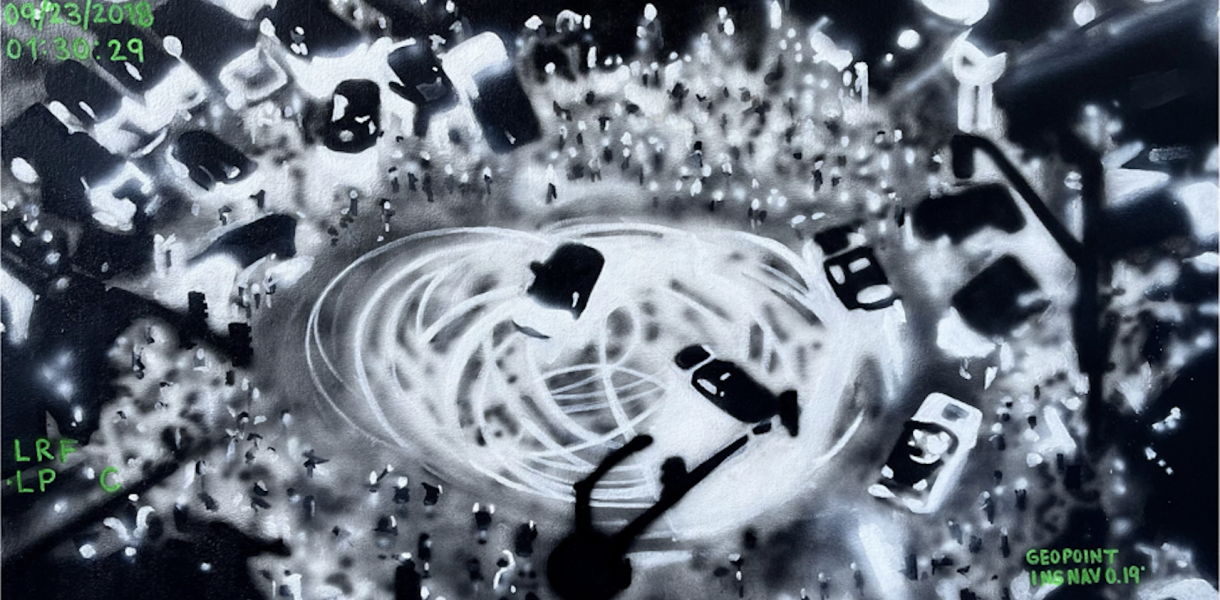By Mario Hernandez

In early November, I took in Eric Collins’ show, Takeover, at Last One’s gallery in Oakland’s Laurel District. A Bay Area native and graduate of San Francisco State in Painting and Art Education, Eric has shown his work in galleries throughout the Bay Area. This exhibition focuses on a central theme of Oakland’s identity, the sideshow. Sideshows have emerged as a defining characteristic of the Bay Area’s unique cultural identity, especially in music and film. Since its beginnings, city administrations have aggressively policed these gatherings. Eric’s work captures the complexity and the raw energy of these impromptu events, and questions if these are acts of civil disobedience or resistance to the criminalization of black and brown youth culture which underlies aggressive policing practices.
Defining what the sideshow is and interpreting its larger meaning can be rather elusive. The practice itself involves crowds of onlookers, loud music and even louder car engines and sounds of tire wheels burning on the pavement as they furiously spin in circles (dugouts), figure eights and jerking start and stop motions (gas, break, dip). As KQED writer Sandhya Dirks put it, they’re similar to “pop-up parties- part car show, part block party”. In works like DTLA and Takeover 5, Eric seems to capture the frenzied motion of the cars, excitement of the crowds, and even the large amounts of smoke such events produce. As the artist stated in an interview over email:
“Graffiti was my introduction into art and I am still heavily involved in the culture today. Within that subculture comes vandalism, theft, robbery, violence and police interaction. I have been following these themes in my fine art practice, looking for the movement in subjects in order to direct my brushwork. I found myself painting sideshows to capture their chaotic nature and hectic environment…Keeping it black and white allows me to work fast and loose, focusing on capturing the atmosphere instead of color. After everything is blocked in, I’ll work back and forth between pens, brushes, and an airbrush to achieve the distorted, smokey effect.”

Because sideshows often occur in busy intersections, parking lots, traffic stop lights and sometimes in the middle of freeway traffic, they are always sporadic, ephemeral and impromptu. In works like Takeover 4, The Takeover and DTLA, pedestrians and commuters stand suspended as the sideshows bring all traffic to a standstill. Commenting on the deliberate and intentional disruption to the organized flow of the city’s “natural” operation, Eric says , “to me, the sideshows display rebellion and disobedience”.
Though Eric’s work is a combination of brushwork and paint on canvas, the depictions are made to resemble photographs or surveillance video image stills. The suggestion is one of police surveillance, either CCTV cameras that are often and increasingly monitoring our every movement on city surveillance cameras, or a police helicopter hovering over the sideshow, tracking its development for patrolling squad cars below. In most of the works listed above, the only color in the composition is the green dashes and intelligible sequences of numbers and letters which resemble security cameras. As the artist describes, “When it comes to painting the actual pieces, I comb through hours of CCTV and CHP helicopter footage to find the perfect layouts. Lately, I’ll combine three or four different scenes to create my own.”
It is for good reason that some see the sideshows as disorderly and a danger to public safety, many people have gotten hurt at these events over the years. Various task forces have been devised over the past decades to stamp out the practice, and as the anthropologist Jennifer Tilton has noted, such measures have historically functioned to criminalize black and brown youth.

Waves of Black and Latinx families came to Oakland during WWII in search of opportunity and a better standard of living, but the decades after the war marked a period of diminishing industries, urban disinvestment and suburbanization (often called white flight) that left communities of color increasingly isolated. Successive waves of “Urban Renewal” policies would only serve to further exacerbate conditions, as freeway and BARTconstruction was often routed through the heart of black and brown communities.
In her book, Dangerous or Endangered? Race and the Politics of Youth in Urban America, Jennifer describes an urban environment of Oakland that offered few spaces for young people to go, much less provide financial opportunity. In the early 1990s when young people began using abandoned and semi-abandoned spaces, such as the parking lot of Eastmont mall in East Oakland (which was the former site of the Chevrolet assembly plant that provided innumerable enumerable jobs at one time), in order to “play music, dance, and show off candy painted Corvettes and Mustangs with gold rims” as she puts it, “a true Oakland original” was created. The early sideshows represented a reclaiming of space and offered a sanctuary from the harsh realities of the street. As one early observer put it, “It was just black folks and cars everywhere. It filled the whole lot…people was walking around just talking and having fun…people weren’t looking at us as if we were a threat”. (Tilton, p. 156)

In the late 1990s, As neoliberal policies of fiscal austerity began to take hold of cities around the country, Oakland was no different. Market-oriented growth strategies would lead to widespread gentrification and the displacement of African American residents in particular (the city lost 25 percent of its Black population from 2000 to 2010 alone). Then mayor, Jerry Brown’s plan to attract 10,000 new residents to the city was supported by increased policing measures that targeted the sideshows in particular. First in 2001 (by intensifying patrols and seizing participant’s property) and again in 2005 (with policies to make sideshow spectating illegal). Many have argued that such anti-sideshow laws and policing tactics were used as a pretext to target groups of Black and brown teens. Where sideshows were once stationary gatherings in places like Eastmont Mall, police harassment forced sideshows to go mobile and become more spontaneous. Rather than allowing themselves to be erased by a new vision of the city that didn’t include them, as Ariana Bindman of SFGate put it, “the distant roar of engines act like voices well into the night, demanding to be heard”. As Cristina Cielo writes, “both in their early days and now, sideshows were and are stolen moments for the youth who attend them, in spaces they can only temporarily claim as their own.” (Cielo, p.21). Eric’s show captures this refusal, and the daringness to lay claim to space, however temporary.
—————————————————————————————————————————-
Mario Hernandez is an assistant professor and Fletcher Jones program chair of Sociology in the Department of Social and Historical Studies at Mills College at Northeastern University. Hernandez is an urban sociologist who specializes in the study of gentrification. His book, Bushwick’s Bohemia: Art and Revitalization in Gentrifying Brooklyn, examines the proliferation of the creative art scene in the neighborhood of Bushwick in Brooklyn, New York within the context of neoliberal strategies of urban growth, including city branding. Dr. Hernandez’s research examines the increasing importance of creative industries to urban economies and the vital role of artists and art scenes in this process. Hernandez is born and raised in the Bay Area, and currently resides in Oakland.
Images:
- The Takeover; Courtesy of Eric Collins
- The Takeover 4; Courtesy of Eric Collins
- DTLA; Courtesy of Eric Collins
- Untitled; Courtesy of Eric Collins

